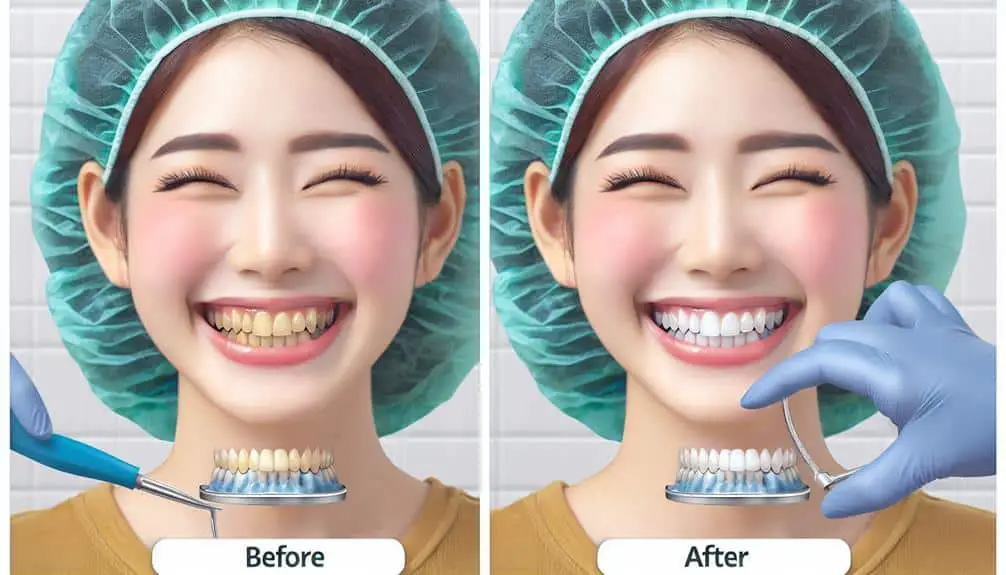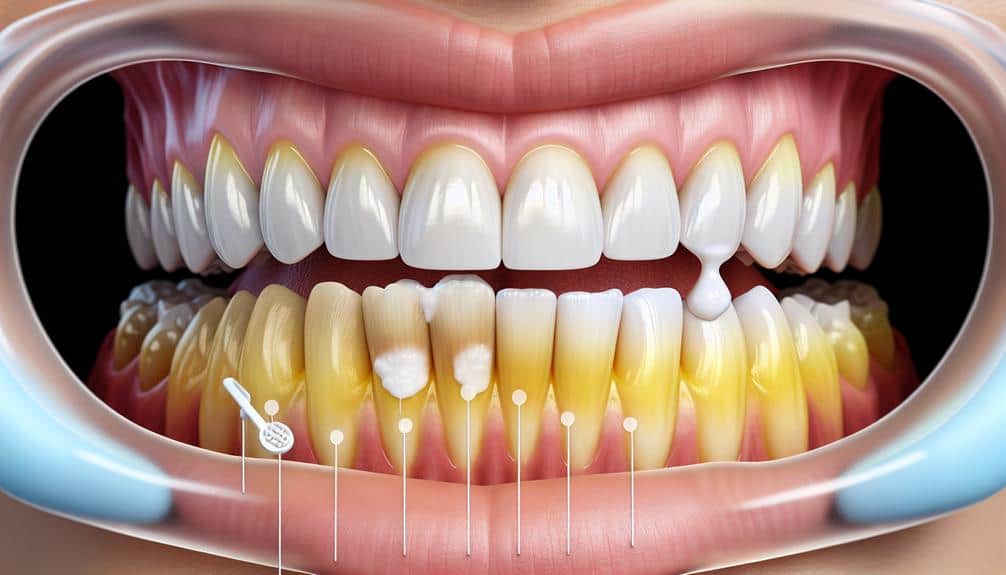To whiten genetic tooth discoloration, consider chairside bleaching or laser whitening. These procedures offer rapid results tailored to your needs. At-home whitening kits with custom trays and gel can target genetic stains effectively. Use whitening toothpaste and mouthwash containing hydrogen peroxide. Adjust your diet by consuming teeth whitening foods like apples and carrots. Get dental advice for long-term maintenance tips. Embrace these proven techniques to transform your smile.
Key Points
- Professional whitening procedures tailored to genetic discoloration.
- At-home kits with custom trays for effective gel application.
- Incorporate whitening products like toothpaste and mouthwash.
- Dietary adjustments with teeth whitening foods and calcium-rich options.
- Consult a dental professional for personalized treatment plans.
Understanding Genetic Tooth Discoloration
To comprehend genetic tooth discoloration, it's important to explore the underlying causes at a molecular level. Genetic causes play a significant role in the color of your teeth. Variations in specific genes can lead to differences in enamel thickness, which affects how light reflects off the teeth, resulting in discoloration. Understanding these genetic factors is essential in determining the appropriate treatment options.
When it comes to treating genetic tooth discoloration, it's vital to explore the underlying cause. Professional dentists can provide personalized treatment plans based on your specific genetic makeup. Treatment options may include professional teeth whitening procedures, such as at-home tray whitening or in-office bleaching. In some cases, cosmetic treatments like veneers or bonding may be recommended to improve the appearance of discolored teeth.
Professional In-Office Whitening Procedures
Professional in-office whitening procedures offer effective ways to enhance the color of your teeth. Chairside bleaching process, laser teeth whitening, and Zoom whitening treatment are popular methods used by dental professionals.
These procedures can provide rapid results and are often tailored to suit individual needs.
Chairside Bleaching Process
Using a high-concentration bleaching gel, dentists can effectively whiten tooth discoloration during chairside bleaching procedures. Chairside treatment benefits include immediate results due to the professional-grade bleaching agents used.
However, it's important for dentists to follow bleaching safety precautions to minimize potential side effects such as tooth sensitivity and gum irritation. Before starting the procedure, protective measures like gum shields are placed to shield the gums from the bleaching agent.
The bleaching gel is then carefully applied to the teeth and activated using a special light or laser to enhance the whitening process. Chairside bleaching is a popular choice for individuals seeking rapid and noticeable improvements in tooth color, under the careful supervision of dental professionals.
Laser Teeth Whitening
For effective and efficient whitening of tooth discoloration, consider laser teeth whitening procedures performed by trained dental professionals.
Laser technology in teeth bleaching is a cutting-edge method in cosmetic dentistry. The process involves the application of a laser beam to activate the bleaching agent on the teeth, enhancing the whitening effect. This technique is known for its precision in targeting specific areas of discoloration, resulting in a more uniform and brighter smile.
Additionally, laser teeth whitening can aid in enamel restoration, providing a dual benefit by both whitening the teeth and strengthening the enamel. If you seek a quick and effective solution to tooth discoloration, laser teeth whitening may be the ideal choice for achieving a radiant smile.
Zoom Whitening Treatment
Experience the cutting-edge technology of Zoom Whitening Treatment for effective in-office tooth whitening procedures. Before undergoing this treatment, a pre-whitening evaluation and oral health assessment are essential to guarantee suitability.
Zoom Whitening Treatment utilizes a hydrogen peroxide-based gel and a specially designed light to break down stains and discoloration on the enamel and dentin surfaces. During the procedure, sensitivity management is employed to minimize discomfort.
Post-treatment care involves avoiding staining substances like coffee, tea, and tobacco to maintain the results. The speed and efficacy of Zoom Whitening make it a popular choice for those seeking immediate and noticeable improvements in tooth color.
At-Home Whitening Kits for Genetic Discoloration
To effectively address genetic tooth discoloration at home, consider utilizing whitening kits specifically formulated for such discoloration. These kits often include custom trays that guarantee the gel application is uniform and reaches all areas of the teeth needing treatment. Custom trays are vital in maximizing the effectiveness of the whitening gel. The gel used in these kits is designed to target genetic discoloration, penetrating the enamel to break down stains and brighten the teeth from within.
When using at-home whitening kits for genetic discoloration, follow the instructions carefully to achieve best results. Apply the gel to the custom trays as directed and wear them for the specified amount of time. It's important not to exceed the recommended usage to prevent sensitivity or damage to the teeth and gums. Consistency is key when using these kits, so stick to the prescribed schedule for the greatest outcome.
Incorporating Whitening Toothpaste and Mouthwash
Consider incorporating whitening toothpaste and mouthwash into your oral care routine to enhance the effects of at-home whitening kits for genetic tooth discoloration. Whitening toothpaste typically contains mild abrasives or enzymes that help remove surface stains from teeth. These toothpastes can be beneficial in maintaining the results achieved with whitening treatments. Look for products containing ingredients like hydrogen peroxide, carbamide peroxide, or baking soda for effective whitening.
Whitening mouthwashes can complement the effects of whitening toothpaste and kits. They often contain hydrogen peroxide or other whitening agents that help lighten tooth discoloration. Using a whitening mouthwash after brushing can reach areas that may have been missed during brushing, providing a more thorough whitening effect.
While whitening toothpaste and mouthwash can be helpful, they may not be as potent as professional whitening treatments or strips. However, for maintenance and improvement of overall tooth color, they can be valuable additions to your oral care routine. Remember, consistency is key when using these products alongside DIY whitening remedies or professional treatments.
Dietary Adjustments for Whiter Teeth
Adjusting your diet can play a crucial role in achieving whiter teeth.
Understanding how different foods and beverages impact tooth discoloration, distinguishing between acidic and alkaline foods, and being aware of the staining effects of sugars are key points to bear in mind.
Food and Beverages Impact
Making dietary modifications can greatly impact the whiteness of your teeth. When aiming to enhance the brightness of your smile, consider the following:
- Teeth Whitening Foods: Incorporate crunchy fruits like apples and vegetables like carrots into your diet. These can help scrub away surface stains.
- Calcium-Rich Foods: Dairy products such as cheese and yogurt can aid in strengthening enamel, promoting a healthier appearance.
- Green Tea: Rich in antioxidants, green tea can help combat plaque buildup, contributing to whiter teeth.
- Water: Drinking water regularly can wash away food particles and reduce the likelihood of staining.
- Vitamin C Sources: Citrus fruits like oranges and strawberries contain vitamin C, which can help prevent discoloration by strengthening gums and tissues.
Acidic Vs. Alkaline Foods
To maintain ideal dental health and promote whiter teeth, understanding the impact of acidic versus alkaline foods in your diet is essential. The pH balance of foods plays a vital role in the health of your teeth.
Acidic foods, with a low pH, can erode enamel over time, making teeth more susceptible to discoloration. On the other hand, alkaline foods, with a higher pH, can help neutralize acids in the mouth, contributing to enamel protection.
Incorporating more alkaline foods like fruits, vegetables, and nuts into your diet can help maintain a healthy pH balance and support enamel health. Being mindful of the acidity of foods you consume can greatly affect the whiteness and overall health of your teeth.
Sugars Staining Effects
When considering dietary adjustments for brighter teeth, understanding the staining effects of sugars is essential for maintaining excellent dental health.
- Sugar Alternatives: Opt for sugar alternatives like xylitol or stevia to satisfy your sweet tooth without promoting tooth discoloration.
- Limit Sugary Drinks: Cutting down on sugary beverages such as sodas and fruit juices can greatly prevent tooth staining.
- Fiber-Rich Foods: Incorporate fiber-rich foods like apples and carrots into your diet to naturally clean teeth and reduce sugar's impact.
- Rinsing After Eating: Rinse your mouth with water after consuming sugary snacks to help minimize their staining effects on teeth.
- Balanced Diet: Ensuring a well-balanced diet with limited sugar intake can go a long way in preserving the whiteness of your teeth.
Consultation With a Dental Professional
Upon noticing any tooth discoloration, seeking a consultation with a dental professional is essential for accurate diagnosis and personalized treatment recommendations. Lifestyle changes and dental advice play an important role in managing tooth discoloration. Genetic factors can also contribute to tooth discoloration, influencing the choice of treatment options recommended by dental professionals.
During the consultation, the dentist will conduct a thorough examination of your teeth to determine the cause of discoloration, whether it be extrinsic stains from lifestyle habits or intrinsic discoloration due to genetic factors. Based on their assessment, the dental professional will provide tailored advice on the most suitable treatment options, which may include professional whitening procedures, cosmetic bonding, or veneers.
Following their recommendations and guidance is crucial to achieving effective results in addressing tooth discoloration. Thus, scheduling a consultation with a dental professional is the first step towards brighter, whiter teeth.
Long-Term Maintenance Tips for Brighter Smiles
For maintaining brighter smiles in the long term, consistent adherence to proper oral hygiene practices is key. Implementing preventive measures and incorporating good oral hygiene habits into your daily routine can help preserve the results of any whitening treatments you undergo.
Here are some essential long-term maintenance tips for a radiant smile:
- Brushing: Brush your teeth at least twice a day with a fluoride toothpaste to remove surface stains and prevent plaque buildup.
- Flossing: Make sure to floss daily to clean between your teeth and along the gumline, where your toothbrush may not reach.
- Regular Dental Check-ups: Visit your dentist for regular check-ups and professional cleanings to maintain oral health and address any issues promptly.
- Balanced Diet: Eat a balanced diet rich in fruits and vegetables while limiting sugary and acidic foods that can contribute to tooth discoloration.
- Avoid Tobacco: Steer clear of tobacco products as they can cause stubborn stains and harm your overall dental health.
Frequently Asked Questions
Can Genetic Tooth Discoloration Be Completely Reversed With Whitening Techniques?
Genetic tooth discoloration can be challenging to completely reverse with whitening techniques due to the underlying causes. While these methods may offer some improvement, long-term results often require maintenance to manage discoloration effectively.
Are There Any Risks or Side Effects Associated With Using Whitening Products on Genetically Discolored Teeth?
When whitening genetically discolored teeth, be cautious of potential risks. Long-term effects may include enamel damage or increased sensitivity. Consult a dental professional for personalized advice to minimize these risks and achieve best results.
How Long Does It Typically Take to See Results From At-Home Whitening Kits for Genetic Tooth Discoloration?
Like nurturing a seedling, results from at-home whitening kits for genetic tooth discoloration may sprout in about 1-2 weeks. Compared to professional treatments, expect a longer timeline for noticeable effectiveness. Consistent care yields blooms.
Are There Any Specific Dietary Restrictions or Recommendations to Follow for Individuals With Genetic Tooth Discoloration Seeking Whiter Teeth?
For those with genetic tooth discoloration seeking whiter teeth, consider dietary restrictions like limiting pigmented foods and beverages for better whitening effectiveness. Combine with professional recommendations for long-term results in achieving a brighter smile.
Can Genetic Tooth Discoloration Worsen Over Time, Even With Regular Whitening Treatments?
You might wonder if regular whitening can slow down genetic tooth discoloration's progression. While whitening treatments can help temporarily, genetic predisposition means discoloration may worsen over time. Preventive measures and long-term effects should be considered.



